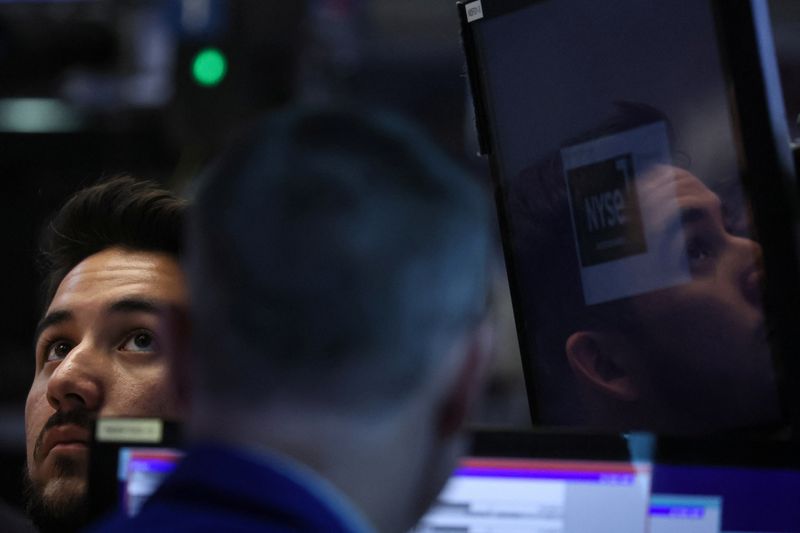By Herbert Lash
NEW YORK (Reuters) -U.S. stocks rose on Monday on expectations corporate earnings will exceed forecasts, but global shares and the dollar traded little changed after data showed the Chinese economy grew slower than anticipated.
China overnight reported growth of 0.8% in the second quarter, above the 0.5% forecast, but the annual pace was 6.3%, well below expectations for a reading of 7.3%. The data indicates China's post-COVID boom is over, analysts said.
But fears earlier in the year of a U.S. hard landing have lessened as slower consumer inflation has brightened the outlook on Wall Street as companies begin to report second-quarter results. Inflation, however, is still above the Federal Reserve's 2% target.
The tech-heavy Nasdaq led U.S. stocks higher, supported by megacap growth stocks including Apple (NASDAQ:AAPL), Nvidia and Tesla (NASDAQ:TSLA), ahead of quarterly results from industry heavyweights later this week.
Tesla Inc is due to report on Wednesday, followed by Bank of America Corp (NYSE:BAC), Morgan Stanley (NYSE:MS), Goldman Sachs Group Inc (NYSE:GS) and Netflix Inc (NASDAQ:NFLX) later this week. "The hurdle rate for companies is a little bit higher than it's been over the last couple of quarters but S&P 500 companies have been able to mostly surpass really low analyst estimates coming into the earnings season," said Anthony Saglimbene, chief market strategist at Ameriprise Financial (NYSE:AMP) in Troy, Michigan.
"What the market is going to be looking for over the next few weeks is whether demand is holding up and are the corporate outlooks still generally positive for the rest of the year?"
James Ragan, director of wealth management research at D.A. Davidson in Seattle, said while earnings are likely to be better than expected, U.S. stocks are unlikely to go much higher given the S&P 500 index is trading at a relatively high 19.7 times forward earnings.
Second-quarter earnings are expected to decline 8.1%, according to Refinitiv data, down further than the 5.7% decline expected at the start of the month.
"We don't see a great path for equities to go a lot higher from here. One reason is just their valuation overall," he said. "Our view is the estimates are still a bit aggressive, especially if we look ahead to 2024. We would not be surprised to see some earnings weakness over the balance of this year."
Stocks in Europe closed lower, with the pan-regional STOXX 600 index down 0.63% while MSCI's gauge of stocks across the globe, which is heavily weighted to U.S. megacaps, edged up 0.11% to a new 14-month high.
On Wall Street, the Dow Jones Industrial Average rose 0.22%, the S&P 500 gained 0.39% and the Nasdaq Composite added 0.93%.
The dollar traded little changed against a basket of currencies after last week suffering its largest weekly decline in 2023 as Treasury yields tumbled.
The currency will likely consolidate as investors await the Federal Reserve's meeting next week, when the U.S. central bank is widely expected to hike rates a further 25 basis points.
Retail sales for June on Tuesday will be the main U.S. economic data for the week, though the news is unlikely to sway the path of monetary policy or market direction.
Data on U.S. retail sales are expected to show a rise of 0.3% ex-autos, continuing the slower trend but solid enough to fit into the market's soft-landing theme.
Futures are pricing in an additional 32 basis points of tightening this year, with the benchmark rate expected to peak at 5.40% in November. That implies the market sees a low chance of further rate hikes after the Fed concludes a two-day meeting on July 26.
The dollar index fell 0.064%, with the euro up 0.08% to $1.1236.
U.S. Treasury yields fell sharply last week as slowing consumer and producer price inflation in June increased expectations that pricing pressures will continue to moderate and lead to more dovish monetary policy.
The two-year Treasury yield, which typically moves in step with interest rate expectations, fell 0.9 basis points at 4.742%, while benchmark 10-year notes slid 1.5 basis points to 3.805%.
Oil dropped by more than 1% after the weaker than expected Chinese economic growth.
U.S. crude fell $1.27 to settle at $74.15 per barrel and Brent settled down $1.37 at $78.50.

Gold prices were little changed, with bullion traders still doubtful about whether the Fed may soon signal an end to its monetary tightening path.
U.S. gold futures settled 0.4% lower at $1,956.40 an ounce.
